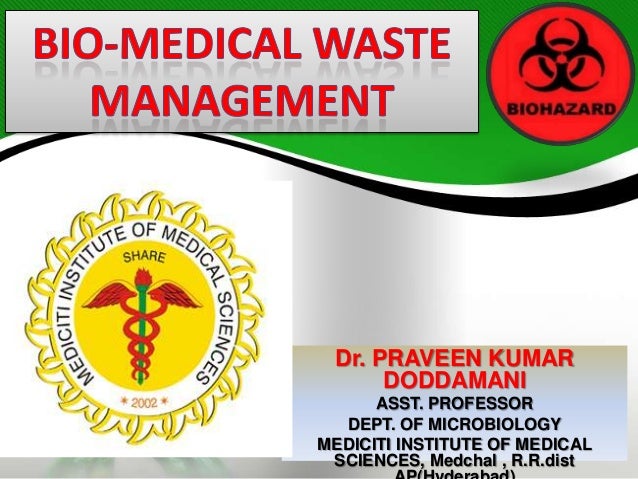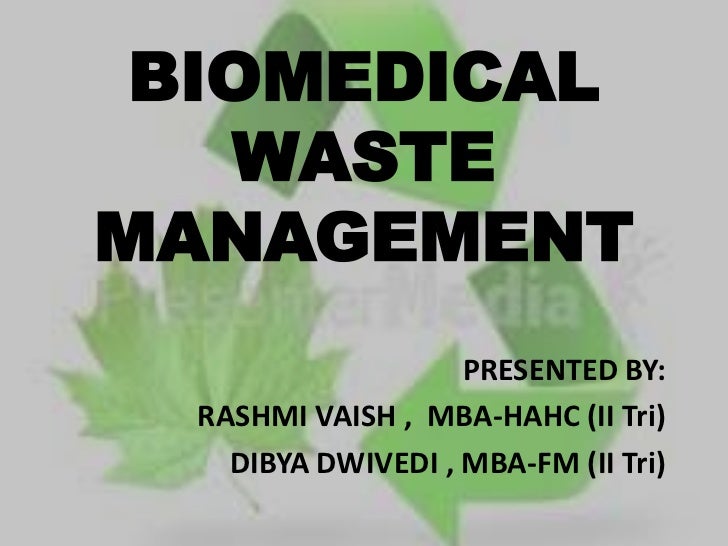Biomedical Waste Management Ppt

Chemical and Pharmaceutical waste. They may be toxic, genotoxic, corrosive, flammable, reactive or explosive.
Radioactive waste. The possible effects can range from headache, dizziness, vomiting to affecting genetic material.
Public Sensitivity. The general public is very sensitive to visual impact of health care waste, esp. Anatomical waste.: Chemical and Pharmaceutical waste. They may be toxic, genotoxic, corrosive, flammable, reactive or explosive.
Radioactive waste. The possible effects can range from headache, dizziness, vomiting to affecting genetic material. Public Sensitivity. The general public is very sensitive to visual impact of health care waste, esp. Anatomical waste. Quantity of Biomedical Waste Generated in Health Care Settings – Developed Countries- 1-5 kg/bed/day, with variations among countries.
In India- 1-2 kg/bed/day with variation among Govt. And Private establishments. 80 percent waste generated in a hospital is non hazardous and can be dealt with normal domestic waste management system. 15 percent pathological & infectious waste.
3 percent chemical & pharmaceutical waste. 1 percent sharps.
1 percent radioactive, cytotoxic and heavy metals.: Quantity of Biomedical Waste Generated in Health Care Settings – Developed Countries- 1-5 kg/bed/day, with variations among countries. In India- 1-2 kg/bed/day with variation among Govt. And Private establishments. 80 percent waste generated in a hospital is non hazardous and can be dealt with normal domestic waste management system.
15 percent pathological & infectious waste. 3 percent chemical & pharmaceutical waste. 1 percent sharps. 1 percent radioactive, cytotoxic and heavy metals. Thermal technology.It uses heat to decontaminate instruments and equipment and the temperatures in this process may rise to extremely high levels.Most of the microbes are destroyed at temperatures below 100°C.1.
Microwave: Thermal technology.It uses heat to decontaminate instruments and equipment and the temperatures in this process may rise to extremely high levels.Most of the microbes are destroyed at temperatures below 100°C.1. MECHANICAL TECHNOLOGY1.
Compaction: Compacting is carried out by a hydraulic ram against a hard surface.2. Grinding / Shredding: Waste material is broken down into smaller particles under negative pressure to avoid any spillage outside the chamber.3. Pulverization: Waste is mixed with large volume of water and bleach solution. The waste is torn to shreds and then fed to an ultra high speed hammer mill with large spin blades which pulverize the matter into small, safe particles.: MECHANICAL TECHNOLOGY1.
Biomedical Waste Management Ppt
Compaction: Compacting is carried out by a hydraulic ram against a hard surface.2. Grinding / Shredding: Waste material is broken down into smaller particles under negative pressure to avoid any spillage outside the chamber.3. Pulverization: Waste is mixed with large volume of water and bleach solution. The waste is torn to shreds and then fed to an ultra high speed hammer mill with large spin blades which pulverize the matter into small, safe particles.
Biomedical waste: Biomedical waste Definition: “Bio Medical waste” is any waste, which is generated during the diagnosis, treatment or immunization of human beings or animals or in research activities pertaining to or in the production or testing of biologicals. Biomedical waste is generated in: hospitals, nursing homes, clinics, medical laboratories, blood banks, animal houses etc. Such a waste can also be generated at home if health care is being provided there to a patient (e.g. Injection, dressing material etc.).
Biomedical Waste Management Rules 2018
Problems associated with biomedical waste: Problems associated with biomedical waste organism Diseases caused Related waste item Viruses: HIV, Hepatitis B, Hepatitis A,C, Arboviruses, Enteroviruses AIDS,infectious Hepatitis, Dengue, tick-borne fevers, etc Infected needles, body fluids, human excreta, soiled linen, blood, body fluids. Bacteria: Salmonella typhi, Vibrio cholerae, Clostridium tetani, Psedomonas, Streptococcus Typhoid, Cholera, wound infections, septicemia, rheumatic fever, endocarditis, skin and soft tissue infections Human excreta and body fluids in landfills and hospital wards, sharps such as needles, surgical blades.

Parasites: Wuchereria Bancrofti, Plasmodium Cutaneous leishmaniasis, kala azar, malaria Human excreta and body fluids in poorly managed sewage system of hospitals. Biomedical waste management rules in india: Biomedical waste management rules in india Ministry of Environment and Forests has revised the Bio Medical Waste (Management and Handling) Rules promulgated under the Environment Protection Act of 1986. The Rules now called the Bio Medical Wastes (Management and Handling) Rules 2011.
According to the Ministry of Environment and Forests ( MoEF ) gross generation of BMW in India is 4,05,702 kg/day of which only 2,91,983 kg/day is disposed, which means that almost 28% of the wastes is left untreated and not disposed finding its way in dumps or water bodies and re-enters our system. News on biomedical waste: News on biomedical waste News» King George's Medical University's double gain in selling biomedical waste TOI 06 Dec 2013, 08:05 IST Here's a perfect example of 'best out of waste'. The biomedical waste management system at King George's Medical University is helping the institute mint handsome money besides contributing to saving the environment. Biomedical waste management seminar concludes at Stanley Medical College TOI 23 Nov 2013, 04:29 IST More than 50 NCC cadets at the Stanley Medical College (SMC) on Friday participated in a seminar on biomedical waste management and would impart the knowledge to other students.